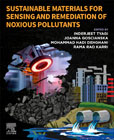
Sustainable Materials for Sensing and Remediation of Noxious Pollutants
Tyagi, Inderjeet
Goscianska, Joanna
Hadi Dehghani, Mohammad
Karri, Rama Rao
Due to rapid urbanization and development, water get polluted by the noxious waste released from industrial, sewage and agricultural runoffs. Sustainable Materials for Sensing and Remediation of Noxious Pollutants covers two most widely used aspects in the field of wastewater i.e. sensing and rapid remediation with a possible solution of successful technology commercialization. Chapters include information on low cost materials as sensing and remediating agents for the rapid removal of noxious impurities from wastewater. It includes chapters on the sensing of noxious metals, low cost adsorbents for the removal of noxious impurities i.e. inorganic (metal ions) and organic (dyes). Additional chapters include future/upcoming scopes of work and one chapter on the general introduction of the field. The book content will be technical and focused for the audience like graduate students, academicians, researchers and industrial professionals. Sustainable Materials for Sensing and Remediation of Noxious Pollutants is single reference source for environmental scientists and engineers interested in low cost sensing and remediation strategies. Assists readers in developing new strategies to address the issues related to sensing and remediation activities Includes low cost materials for sensor and adsorbent development allowing professionals to make decisions based on economic considerations Provides alternatives for the development of socioeconomically sustainable products for sensing and remediation application INDICE: Part 1. Introduction to the general aspects of sensing and remediation materials Part 2. Synthesis of sensing material for the detection of Macrocyclic and Rotaxanes Part 3. Sensor material for detection of noxious metal impurities Part 4. Conducting polymer based sensing materials for water treatment Part 5. Graphene oxide nanocomposite for the remediation of micropollutants (Pharmaceutical Impurities and Metal Ions) Part 6. Low cost adsorbents (Biomaterials, nanomaterials, waste materials) for the remediation of noxious pollutants (inorganic and organic) from wastewater Part 7. Outlook of Industries and their expectations in terms of cost-economics and societal benefits
- ISBN: 978-0-323-99425-5
- Editorial: Elsevier
- Encuadernacion: Rústica
- Páginas: 300
- Fecha Publicación: 01/08/2022
- Nº Volúmenes: 1
- Idioma: Inglés
